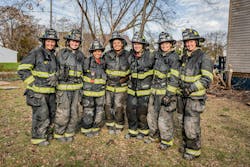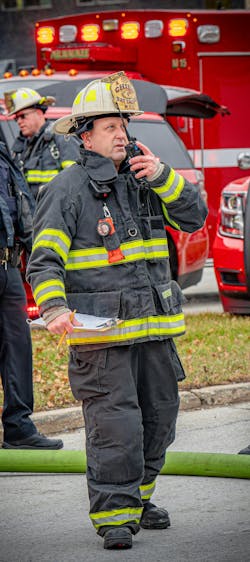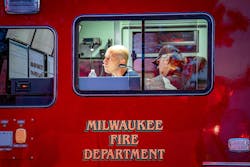Milwaukee Fire Department 150th Anniversary: Technology & Re-Growth
Technology is becoming more and more a part of firefighting,” James Zeich, who is deputy chief of training for the Milwaukee Fire Department (MFD), says. “Yes, firefighting still is a grunt-style job, but we have to adapt and learn.”
Undoubtedly, that’s what the MFD is doing, and it’s doing it in regard to firefighter training but also in the realms of hazmat response, fleet and facilities management, and member recruitment, among other facets of the department. The efforts are impressive, to say the least, and they serve as considerations for agencies of all types and sizes.
Training: Meet them where they are
Many a training officer has contemplated approaches to keep member students engaged. The matter might be in play most in sessions that take place away from live fire training grounds. The MFD has noticed that the design and operation of virtual training programs, particularly the newest iterations, are advantageous in this regard. A notable example is the department’s use of SimsUShare fire simulation and training software to train company officers, battalion chiefs and deputy chiefs.
“Officers can get their radios and do full-fledged scenarios without leaving the firehouse,” Zeich explains.
The department finds significant benefit from the software’s capability for allowing scenarios to be tweaked over and over—made better and worse—based on the tactics that an officer chooses to apply during a training session.
Engagement also is important when it comes to the newest members of the department. MFD Media Specialist Dawn Haase tells Firehouse that she has an obligation to “create training to keep it as attention-getting as possible.
“Our members who are coming on now, all they know is technology, so leadership must adapt to them,” she continues. “We must meet them where they are.” Ekman is supremely confident that this mindset is how leadership is going to relate to them.
Does embracing technology and implementing it widely present a challenge with some of the more seasoned members?
“Part of being a firefighter is adapting and overcoming the situation,” Zeich says. “When older members came on, we didn’t wear SCBA. Now we do. We didn’t wear seat belts. Now we do. Today, it’s a tablet computer or the like.”
“We must provide the comparison,” Haase offers, “and it has to be understandable. The department has done a good job of making sure training isn’t anything too cryptic for older members to pick up on yet isn’t something that newer members will be bored with because they know it already.” In short, she urges departments to understand the learning ability and age groups of their members.
Hazmat: Free to mitigate
From her experience with expanding the use of technology for trainings, Haase knows that the same has been very useful for the MFD’s involvement with its shared services program with neighboring departments (see “Shared Services: Moving Forward”) and its special teams, including hazmat response. In regard to special teams, the department continues to broaden the utilization of drones, robots and other sophisticated devices.
In 2020, the MFD put into service its new Hazmat 1 rig. However, despite its sophistication, hazmat technicians still had to radio gas monitor readings to the command post officers in Hazmat 1, which, unsurprisingly, was time consuming. About 18 months ago, RAE Systems monitors that automatically stream readings in real time to the hazmat vehicle were acquired.
“Because technicians don’t have to spend time sending meter readings to command, they’re freed up to focus on mitigation,” Capt. Mike Thurow, who is the director of the MFD hazmat team, says.
“There’s a plethora of technology that we have at our fingertips now,” Thurow adds, which allows the hazmat group to aid the Heavy Urban Rescue Team (HURT). “If they are on a confined space run, we can help in regard to metering, including to make sure that they make proper PPE selections,” Thurow states.
As for robotics, the hazmat team is working to obtain a grant that would let it acquire Boston Dynamics’ SPOT robotic dog, possibly as a Wisconsin state asset. Outfitted with an array of sensors and meters, the robot could be sent into the scene of a train derailment, for example.
“We could actually see what the conditions are without jeopardizing any of our firefighters by sending them into a hazardous situation,” Thurow adds.
In conjunction with what Haase noted about newer members and their general affinity for technology, Thurow tells Firehouse, “We’re a very young department, and we have some great members who are really stepping up to take on these special teams positions and the special training that’s associated with them.
“It all starts at the top,” including Fire Chief Aaron Lipski and Special Operations Division Chief Joseph Hegeman, Thurow continues. “They both have been very encouraging for me to go out and get the training. So, as the future unfolds and the technology keeps coming out, there are some really great things that we can do to keep our firefighters and the community safer.”
Recruitment: Minimize the clicks
Capt. Phil Cockroft, who is the MFD’s recruitment resource director, says that technology is aiding him and his team as far as the efforts to “meet them where they are” that Zeich referenced. Department applications have been available online for years, but they weren’t mobile-friendly.
“If a member of the department meets someone on the street and that person is interested in being a firefighter, you want that person to be able to access stuff from their smartphone quickly and efficiently and to be able to save it,” Cockroft explains. “The department created a digital business card that incorporates a QR code. This means that an interested party can scan the QR code with their phone and fill out the employment application with that device.”
It’s all about minimizing the clicks, Cockroft stresses. “If things are too complicated, if things are too hard to find, folks get frustrated, and they’re just going to move on.”
All of the complications that resulted from COVID-19 caused the MFD to “move forward as far as using technology as a tool,” he adds, “because of the social separation and folks being on their devices more.”
The QR code for applying is shared with firefighters to pull off of their phone, and it was made into a sticker to put on rigs.
“Members are a department’s best ambassadors for the occupation and the career,” Cockroft believes. “For them to be able to pull up the QR code goes a long way toward reaching potential applicants.”
Fleet and facilities
When the MFD purchased ManagerPlus enterprise asset management software (now Eptura Asset) to track all of its equipment (vehicles and otherwise), the software worked well but required data to be kept on a server. The latest iteration is cloud-based, and MFD Facilities Manager Mike Reid tells Firehouse that the new version upgrades his department’s flow of requisitions, inspections, product updates, inventory, purchase orders and budget requests. Bar coding of parts was available originally, but the department is in the process of updating that facet of its system.
With the old system, the department could only use certain bar code readers, and bar codes were tied to particular products, not categories of products. Reid’s expectation is that he and his team will be able to create a bar code for, say, air filters, to use for inventory management, rather than the filter manufacturer’s bar code. This means that if the department changes filters, it can affix the MFD’s existing bar code for filters on the new filter rather than entering a new manufacturer filter into the system. This leads to better efficiencies, which drill down to the bottom line.
Always moving forward
Lipski tells Firehouse that one of the department’s most recent acquisitions of technology was its purchase of 50 units of Ascent Integrated Tech’s location tracking system. It and everything that’s noted above and much more all contribute to the department’s ongoing efforts to distinguish itself from so many other Rust Belt departments that are struggling with response and personnel.
“We are re-growing,” Lipski proudly proclaims, and technology is a tool that’s helped to do that and will continue to.
About the Author
Rich Dzierwa
Managing Editor, Firehouse Magazine
Rich Dzierwa joined Firehouse Magazine in 2019 after four tenures with other publications. He was editor-in-chief of Consumers Digest/ConsumersDigest.com and of trade magazine Cutting Tool Engineering. He served as the consumer products reporter for BridgeNews and began his publishing career with an 11-year tenure at Appliance magazine, where he rose to managing editor after serving in other roles. Dzierwa's experience with consumer products, including furnishings, appliances, electronics and space design, has transferred to his Firehouse work regarding the magazine's Station Design columns and the Station Design Awards. Previous work also has contributed to his supervision of several surveys of fire service/EMS members, to produce unique reporting for Firehouse's audience. Dzierwa earned a bachelor's degree in English from Columbia College Chicago.



